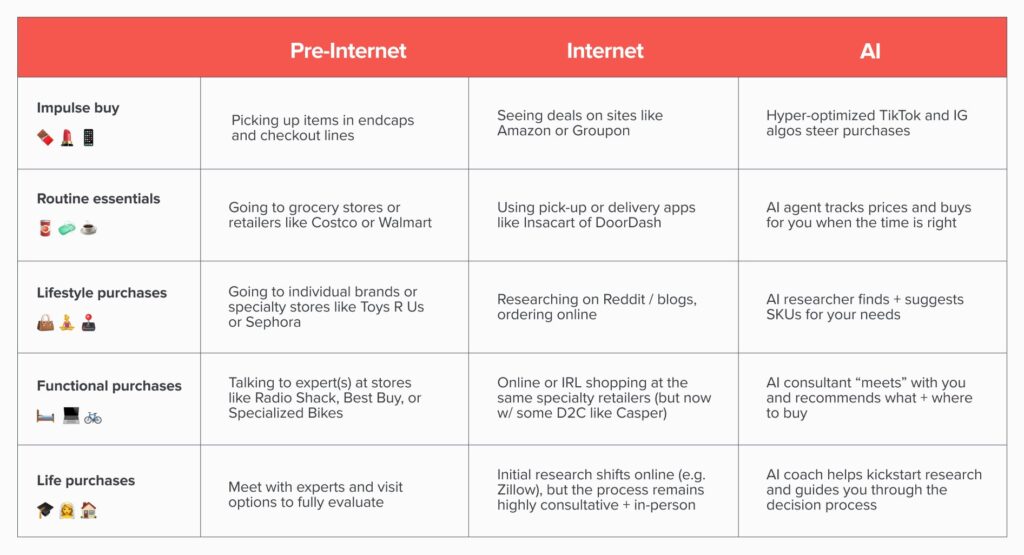In the peculiar tradition of Silicon Valley venture capital, where the most mundane human activities are inevitably reimagined as “trillion-dollar market opportunities,” Andreessen Horowitz has unveiled their latest thesis: AI x Commerce. This represents their belief that artificial intelligence will fundamentally transform how we shop, from product discovery to evaluation, timing, and purchase completion. The premise, while ostensibly revolutionary, bears the hallmarks of a familiar pattern—the systematic automation of human decision-making under the guise of “liberation from tedious choices.”
The investigation begins with a deceptively simple observation: shopping, according to a16z’s analysis, can be categorized into distinct behavioral patterns that artificial intelligence is uniquely positioned to “disrupt.” Their research identifies five primary purchase categories, ranging from impulse buys to major life decisions, each presenting what they term “unique opportunities for AI intervention.”

The Case of the Automated Impulse Purchase
Consider first the curious evolution of the impulse buy. In the pre-digital age, this phenomenon manifested as the strategic placement of candy bars near grocery store checkout lines. The internet era introduced us to Amazon’s one-click purchasing and flash sales on deal sites. Now, according to a16z’s thesis, we have entered the age of “hyper-optimized TikTok and Instagram algorithms” that can steer purchases with unprecedented precision.
The progression reveals a fascinating pattern: each technological advancement has made impulsive consumption more frictionless, yet venture capitalists consistently frame this as consumer empowerment rather than behavioral manipulation. The latest iteration involves AI agents that can complete purchases on behalf of users, ostensibly to save time and cognitive energy. One must wonder whether the true beneficiary of this “convenience” is the consumer or the platforms that can now bypass the last remaining friction point—human deliberation.
The Mystery of Routine Essential Automation
Perhaps more intriguing is the transformation of routine purchases. The journey from physical grocery shopping to Instacart delivery apps already represented a significant behavioral shift. Now, a16z envisions AI agents that track prices and automatically purchase essentials when conditions are optimal. This evolution from manual shopping to algorithm-driven procurement raises questions about consumer agency that the venture capital thesis conveniently sidesteps.
The technical requirements for this automation are revealing. As outlined in their analysis, these systems require “unified APIs” across retail platforms, sophisticated identity and memory systems, and “embedded capture” mechanisms that infer preferences from user behavior. The infrastructure described sounds remarkably similar to comprehensive surveillance apparatus, rebranded as “personalization technology.”
The Peculiar Case of Lifestyle Purchase Guidance
The transformation of lifestyle purchases presents perhaps the most interesting puzzle. Previously, consumers might research products on Reddit or specialized blogs before making decisions. The a16z thesis suggests that AI researchers will soon “find and suggest SKUs for your needs,” eliminating the need for human research and evaluation.
This shift represents more than technological convenience—it suggests a fundamental transfer of decision-making authority from humans to algorithms. The venture capital narrative frames this as liberation from tedious research, but the underlying mechanism appears to be the commodification of personal taste and preference formation. When AI agents curate lifestyle choices, the distinction between authentic personal preference and algorithmic influence becomes increasingly opaque.
The Investigation into “Functional Purchase” Optimization
Traditional functional purchases—electronics, appliances, tools—typically involved consulting experts, reading reviews, and comparing specifications. The AI commerce model proposes to replace this process with algorithmic consultants that “meet with you and recommend what and where to buy”.
Early evidence suggests this transition is already underway. Users report converting functional purchase queries to ChatGPT and Claude, citing benefits including “no ads, no nonsense, and seemingly data-driven side-by-side product comparisons”. The appeal is understandable, yet the underlying assumption—that algorithmic recommendations are inherently more objective than human expertise—warrants scrutiny.
The Case of Life Purchase Decision Automation
Most audacious is the proposed AI intervention in major life purchases—homes, vehicles, education. The a16z thesis suggests that AI coaches will “help kickstart research and guide you through the decision process”. The transformation of life-altering decisions into algorithm-guided processes represents perhaps the most profound shift in their commercial vision.
The technical challenges are significant. These AI systems must process vast amounts of contextual information, understand individual financial constraints, and navigate complex regulatory environments. More fundamentally, they must somehow encode human values and life priorities into computational frameworks. The venture capital enthusiasm for this challenge suggests either remarkable confidence in AI capabilities or a concerning willingness to reduce human complexity to optimizable parameters.
The Elementary Deduction: Infrastructure Over Innovation
Upon closer examination, the AI x Commerce thesis reveals itself to be primarily concerned with infrastructure development rather than consumer benefit. The key technical requirements—unified APIs, comprehensive user profiling, embedded behavioral tracking—represent significant business opportunities for companies positioned to provide these services.
The pattern is familiar: venture capital identifies a human behavior, reframes it as an “inefficiency,” and funds technology companies to automate the process. The consumer benefits are presented as primary motivations, while the actual value creation occurs through data collection, behavioral influence, and platform intermediation.
The Strange Evidence of Market Timing
The timing of this thesis is particularly intriguing. Major technology companies including Amazon, Google, Walmart, OpenAI, and Shopify are simultaneously racing to build AI shopping assistants while blocking competitors from accessing their data. This suggests that the “AI x Commerce” opportunity may have less to do with consumer demand and more to do with competitive positioning in an emerging market.
The venture capital thesis arrives precisely when these platforms need investment capital to build the infrastructure for AI-driven commerce. The alignment between funding requirements and investment themes is rarely coincidental in Silicon Valley’s ecosystem.
The Solution: Agentic Commerce as Digital Feudalism
The ultimate vision presented in the a16z thesis—”agentic commerce”—describes AI agents that can “browse, compare, shortlist, recommend, and even pay” on behalf of consumers. This represents a complete delegation of commercial decision-making to algorithmic intermediaries.
The implications extend beyond mere convenience. When AI agents control purchase decisions, consumer choice becomes algorithmic choice. Brand relationships become mediated by AI preferences. Market dynamics shift from consumer-driven demand to algorithm-optimized outcomes. The venture capital thesis frames this as consumer empowerment, but the actual power structure appears to favor platforms and AI providers over individual users.
The Inevitable Conclusion: The Commodification of Choice
The AI x Commerce thesis ultimately represents the logical conclusion of platform capitalism: the transformation of human decision-making into an optimizable, monetizable process. Every choice becomes data, every preference becomes a parameter, every purchase becomes training material for increasingly sophisticated behavioral modification systems.
The venture capital enthusiasm for this transformation reveals a fundamental assumption about human nature—that choice itself is a burden to be automated away rather than a fundamental aspect of personal agency. This perspective may explain why the thesis focuses extensively on technological capabilities while barely acknowledging the psychological and social implications of delegating commercial decisions to AI systems.
The mystery of AI x Commerce solves itself once we recognize that the primary customer is not the individual consumer but the platforms and companies seeking to capture and monetize human commercial behavior. The technology serves its intended purpose perfectly—it simply serves different masters than the marketing suggests.
As we observe this latest venture capital thesis unfold, one cannot help but wonder whether we are witnessing the final phase of commercial automation or simply the most sophisticated iteration of an ongoing experiment in algorithmic influence. The answer, as with all good mysteries, may become clear only after the transformation is complete and irreversible.
What’s your take on AI taking over your shopping decisions? Are you ready to let algorithms choose your next purchase, or do you still believe in the ancient art of actually deciding what you want? Have you tried any AI shopping assistants, and if so, did they understand your needs better than you do?
Enjoyed this dose of uncomfortable truth? This article is just one layer of the onion.
My new book, “The Subtle Art of Not Giving a Prompt,” is the definitive survival manual for the AI age. It’s a guide to thriving in a world of intelligent machines by first admitting everything you fear is wrong (and probably your fault).
If you want to stop panicking about AI and start using it as a tool for your own liberation, this is the book you need. Or you can listen to the audiobook for free on YouTube.
>> Get your copy now (eBook & Paperback available) <<





GIPHY App Key not set. Please check settings